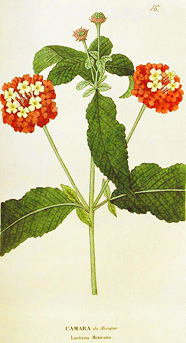Lasting Lantana
By Audrey Stallsmith

A couple of fairy insects, who rise
And fall, and quiver, among the lights,
And circle around the lantana blooms,
The orange colored lantana, and play
With the blooms which are just as yellow as they;
And lose themselves in the jungle glooms.
"Our Cocoanut Garden" by Robert Burleigh Campbell
My potted lantanas are among the few plants still blooming now in October. Since they are hardy only in zones higher than 8, I probably will need to bring them indoors in a couple weeks. When I do that, they often drop all of their foliage in what only can be described as a dramatic flourish.
No, they doesn’t make them either deciduous or dying. They simply get rid of their outdoor leaves so they can produce new ones more adapted to the lower illumination under my grow lights. Many other woody plants, such as tropical hibiscus and fuchsia will do the same thing, though perhaps not all at once!
Sometimes known as shrub verbenas, lantana plants actually are quite tough, standing for “rigor” in the Language of Flowers. They are so tough, in fact, that they are considered invasive weeds in tropical climates, where some can grow to six feet in height and bloom almost year round.
Once they recover from their move, mine generally will flower under the grow-lights over the winter, though not as heavily as they do outdoors. Their name derives from their supposed resemblance to wayfaring tree, AKA Viburnum lantana.
I like the fact that their 1 to 2-inch clusters of tiny blooms include two or three colors, usually with the outer rings being a different hue or hues than the inner ones, though sometimes all of the tints are muddled in together. That multiplicity of colors is why the flowers in Campbell’s poem can be described as both orange and yellow.
Of the lantanas I have blooming now, the oldest has a trunk a couple inches across and flowers that combine red, magenta, and yellow. One of my smaller plants has yellow and white flowers and another yellow and pink.
Although attractive to butterflies and hummingbirds, lantanas are poisonous to livestock, so you’ll want to keep them out of your pastures. There is so much disagreement over whether the plant and its berries are toxic to humans that I can’t give you a definitive answer on that. A report in Reuters a while back pointed out that, of the children treated after imbibing lantana, only about one tenth of them showed any symptoms at all and those symptoms proved to be mild.
Due to the fact that the plant is used medicinally in some cultures--to heal wounds and skin diseases, induce sweating, relieve flatulence or spasms, and even treat malaria--we'll have to conclude that it isn't always toxic.. However, considering that it can kill cows and that I am a much smaller animal, I wouldn’t take a chance on consuming either the leaves or the berries, no matter what those fruits’ degree of ripeness!
Besides, lantana’s rough foliage has what Louise Beebe Wilder describes in The Fragrant Path as a “curious oily pungent odor,” which isn’t particularly appetizing. She notes that “The smell of the Lantana is not disagreeable to all persons but I have known those who were made actually ill by it.”
Fortunately, that odor isn’t obvious unless you crush the leaves and it doesn’t smell all that bad to me. Kind of a musky scent which—as somebody else observed--combines hints of both citrus and gasoline.
You can find more information on lantana's berries, the germination of its seeds, and winter care of the plant in my eHow articles on those subjects:
What Do Berries on My Lantana Plant Mean?
Winter Care for Lantana Plants
The same ever-blooming characteristic which makes the plant a nuisance in more tropical zones makes it an inspiration to those of us who don't get many flowers in winter. Proving again that one person's trash can be another person's treasure!
The lantana image is from the 1817 Annales de Flore et de Pomone, courtesy of plantillustrations.org.








